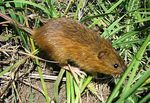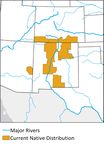New Mexico Meadow Jumping Mouse
←
→
Page content transcription
If your browser does not render page correctly, please read the page content below
C O L O R A D O P A R K S & W I L D L I F E
New Mexico Meadow Jumping Mouse
ASSESSING HABITAT QUALITY FOR PRIORITY WILDLIFE SPECIES IN COLORADO WETLANDS
Species
Distribution
Range
New Mexico meadow jumping mice
are endemic to New Mexico, Arizona,
and small portions of southern
Colorado. Since listing, they have been
documented at 31 new locations where
they had not previously been detected
or where surveys had never been
conducted. Of these, 24 were in areas
outside of designated critical habitat.
© GREG WRIGHT
The New Mexico meadow jumping mouse (Zapus hudsonius luteus, Family Dipodidae)
prefers tall, dense herbaceous vegetation, typically adjacent to perennial flowing water.
Species Description burrow in drier grassy or wooded
areas, such as adjacent uplands. Some
Identification individuals may overwinter within
The New Mexico meadow jumping riparian zones.
mouse measures 7 to 9 inches, includ-
ing a long tail more than half its length. Diet
Their white undersides contrast with New Mexico meadow jumping mice
grayish brown backs and yellowish consume a wide variety of plant
brown sides. Aided by inch-long back material. While they show a preference
feet, New Mexico meadow jumping for forbs, grass seeds, and flowers, they
mice are notable jumpers. They are also consume small fruits.
generally nocturnal but can be ob-
served during the day. They hibernate Conservation Status
for approximately 8 to 9 months of the Federal: Listed as Endangered in 2014.
year and are usually active only during Colorado: Not listed, designated Tier 1
the summer months. Species of Greatest Conservation Need.
BLM: Listed as Sensitive Species.
Preferred Habitats USFS: Listed as Sensitive Species.
Known as riparian obligates, New
Mexico meadow jumping mice occupy Populations declined sharply in the late
dense, tall, herbaceous vegetation 1980s to early 1990s, leaving only 29
adjacent to flowing streams, irrigation small isolated populations that may not Full species range map from USFWS (2018). Colorado
map based on knowledge of reviewers and endorsed by
ditches, beaver ponds, and slough hab- be resilient over time. They have been USFWS
itats. Less is known about their winter extirpated from at least 70 previously
Version Date: February 2019
hibernation habitat, but they likely occupied sites.
COLORADO PARKS & WILDLIFE • 6060 Broadway, Denver, CO 80216 • (303) 297-1192 • cpw.state.co.usPreferred Habitat Conditions
Distance between habitat patches for within 330 feet
connectivity
Herbaceous vegetation present and dense
Herbaceous vegetation composition a diversity of forbs, grasses, and sedges
Herbaceous vegetation height at least 24 inches at full growth potential,
higher in some areas outside of Colorado
Proximity to water usually adjacent to perennial flowing water
Size of contiguous suitable habitat >15 acres
© GREG WRIGHT
Soil moisture Saturated or nearly saturated
Management Recommendations
This fact sheet contains easy-to-use guidelines for understanding habitat needs of Acknowledgements
Terry Ireland (U. S. Fish and Wildlife Service,
Colorado Parks and Wildlife priority wetland-dependent wildlife. A number of Grand Junction, CO), Alison Michael (U. S. Fish
practical steps can be taken to improve habitat for New Mexico meadow jumping and Wildlife Service, Lakewood, CO), Jennifer
Zahratka (Biological Resources, LLC, Durango,
mouse. CO), Jennifer Frey (Department of Fish, Wildlife
and Conservation Ecology, New Mexico State
University, Las Cruces, NM), Carol Chambers
Hydrology (College of Engineering, Forestry, and Natural
• Avoid irrigation diversions in New Mexico meadow jumping mouse habitat. Sciences, Northern Arizona University, Flagstaff,
AZ), Stuart Tuttle (Ketzel Environmental Training
• Replace outdated water delivery infrastructure with structures that minimize and Services, LLC, Flagstaff, AZ), and Tina
impacts to or enhance habitat. Jackson (Colorado Parks and Wildlife, Denver,
CO) reviewed earlier versions and provided input
• Maintain perennial flowing water that supports suitable habitat prior to and on preferred habitat conditions.
throughout their active season.
Suggested Reading and Citations
Vegetation CPW (Colorado Parks and Wildlife). 2015. State
Wildlife Action Plan. Colorado Parks and
• Promote and maintain native riparian woody shrubs (e.g., willow and alder). Wildlife, Denver, CO.
• Avoid mowing and other surface-disturbing activities in New Mexico meadow Frey, J. K., and J. L. Malaney. 2009. Decline of the
jumping mouse habitat during their active season. meadow jumping mouse (Zapus hudsonius
luteus) in two mountain ranges in New
• Avoid ground disturbance in potential hibernation areas during winter. Mexico. Southwestern Naturalist 54:31-44.
Frey, J. K. 2017. Landscape scale and microhabitat
Land Use of the endangered New Mexico meadow
jumping mouse in the White Mountains,
• Manage livestock grazing to avoid potential negative effects to New Mexico Arizona. Journal of Fish and Wildlife
meadow jumping mouse habitat. Management 8:39-58.
• Avoid development and recreation activities that result in habitat loss. Malaney, J. L., J. R. Demboski, and J. A. Cook.
2017. Integrative species delimitation of the
widespread North American jumping mice
Conservation (Zapodinae). Molecular Phylogenetics and
Evolution 114:137–152.
• Encourage beaver where appropriate and where they maintain New Mexico
U. S. Fish and Wildlife Service. 2014. Recovery
meadow jumping mouse habitat. outline: New Mexico meadow jumping
• Simulate beaver dams where appropri- mouse (Zapus hudsonius luteus).
ate to recover riparian ecosystems. U. S. Fish and Wildlife Service. 2018.
Species profile for New Mexico meadow
• Increase quantity and quality of emer- jumping mouse (Zapus hudsonius
gent wetlands adjacent to perennial luteus). https://ecos.fws.gov/ecp0/profile/
speciesProfile?spcode=A0BX [accessed 21
flowing water. August 2018].
Wright, G. D., and J. K. Frey. 2015. Habitat
selection by the endangered New Mexico
meadow jumping mouse on an irrigated
floodplain. Journal of Fish and Wildlife
Management, 6:112-129. Available: http://
www.fwspubs.org/doi/10.3996/062014-
JFWM-044
Zahratka, J. L. 2016. New Mexico meadow
jumping mouse surveys 2015: Sambrito
© JAMES N. STUART
Wetland Area & Sambrito Creek. Report
© GREG WRIGHT
to Colorado Parks and Wildlife, Southwest
Region, Durango, CO.
COLORADO PARKS & WILDLIFE • 6060 Broadway, Denver, CO 80216 • (303) 297-1192 • cpw.state.co.usDISCLAIMER: This scorecard is designed specifically for the Colorado Parks and Wildlife Wetland Wildlife Conservation Program.
It does not replace protocols required by U. S. Fish and Wildlife Service. Please contact the U. S. Fish and Wildlife Service regarding
questions about their required protocols for species listed under the Endangered Species Act.
Habitat Scorecard for New Mexico Meadow Jumping Mouse (v. Feb 2019)
Assessment of habitat before and after restoration or management actions
Project Name:_______________________________________________________ Date(s) of Assessment: ___________________
Size of project area (acres):_________________________________ Size of habiat area (acres): ____________________________
Instructions: Enter one value that best describes early to late-summer conditions of each habitat variable, using the numbers in the
value column. Habitat variables are in shaded boxes; ranges of condition are directly below each variable. If condition is outside
range or is not described, enter a zero.
Key habitat variable and conditions Value Before After
Height of herbaceous vegetation (overall average within 15 feet of water, measured at peak of growing season)
>24 inches 18.7
>18 – 24 inches 12.5
12 – 18 inches 6.2
Herbaceous vegetation density (overall average within 15 feet of water)
Present and dense (>75% cover) 18.7
Present with >50 – 75% cover 12.5
Present with 35 – 50% cover 6.2
Size of contiguous suitable habitat within the floodplain of perennial flowing stream
>15 acres 18.7
>6 – 15 acres 12.5
2.5 – 6 acres 6.2
Herbaceous composition
Mix of >20 distinguishable species 15.9
Mix of 3 – 20 distinguishable species 10.6
Dominated by 1 or 2 distinguishable species 5.3
Distance between patches of suitable linear habitat (includes neighboring properties)
400 – 500 feet 5.0
Length of perennial flowing water with at least one side having access to floodplain (landscape level)
>5.6 miles 13.1
>3 – 5.6 miles 8.7
1 – 3 miles 4.4
Total (of 100 possible): add all numbers in before or after columnsYou can also read























































